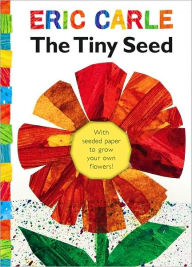The final collaboration from this bestselling author-illustrator team. Young reader's will enjoy Baby Bear's quest to find Mama, and they'll revel in identifying the each of the native North American animals that appear along the way. The central focus on the special bond between mother and child makes a fitting finale to a beloved series.
These groundbreaking picture books have been teaching children to read for more than forty years, and their consistently strong sales prove their staying power and continued applicability for today's kids.
Over 40 years ago, Eric Carle launched his career as a children's book illustrator when he provided the artwork for Bill Martin Jr.'s classic Brown Bear, Brown Bear, What Do You See? Martin died in 2004, but not before he completed the equally embraceable Baby Bear, Baby Bear, What Do You See?, which also features his trademark festive rhythms and rhymes. Carle's colorful pictures strike just the right notes in this celebration of babies and mommies in the wilderness. Now in an enchanting board book.
Publishers Weekly
These clever creators' final collaboration arrives 40 years after their first, Brown Bear, Brown Bear, What Do You See?, joining two previous bear sequels. Much in the same vein as its predecessors, this appealingly cadenced story introduces a sequence of animals, dramatically yet simply depicted in textured collage art against white backdrops. Readers first spot Baby Bear climbing a tree, responding to the question posed in the title: "I see a red fox slipping by me." Red Fox in turn spies a flying squirrel gliding by, who sees a mountain goat climbing nearby, who sees a blue heron flying by and so on until a screech owl-gazing wide-eyed at the reader-sees "a mama bear looking at me." A large-scale image of Mama Bear is followed by a spread revealing what she sees: each of the previously featured animals and (most satisfyingly) "my baby bear looking at me-that's what I see!" Creative action words and renderings of the various creatures in motion give the book a pleasing energy, while Mama Bear's obvious delight at finding her cub provides an endearing poignancy. The elegant balance of art, text, emotion and exposition is a Martin and Carle hallmark; they have crafted a lovely finale to an enduring series. Ages 2-8. (Aug.)Copyright 2007 Reed Business Information
Children's Literature - Pat Trattles
The award winning author/illustrator team of Bill Martin Jr. and Eric Carle does it again in this, the final installment of the classic bear books. Using the same repetitious refrain pattern originally introduced over forty years ago in Brown Bear, Brown Bear, What Do You See?, and echoed in succeeding books, Martin introduces readers to a variety of North American mammals as Baby Bear sets out on his quest to find his mother. Whereas in the original all the animals were "looking at me," in this version Martin uses a variety of action words to describe the unique characteristics of each animal. Baby Bear sees a red fox slipping by, who sees a flying squirrel gliding by, who sees a mountain goat climbing near, etc. Carle's drawings are dramatic, yet simple and capture each animal in motion using bright colors against a bold white background. The repetitious nature of the text makes this a great book for children learning to read. Like the other bear books which proceeded it, it is sure to be enjoyed by parents, teachers, and children of all ages. Reviewer: Pat Trattles
Kirkus Reviews
In its fourth-and billed as final-iteration, this primary level Q-and-A introduces ten North American mammals, from red fox and blue heron to rattlesnake, mule deer and finally (unspecified, but possibly Kodiak) Mama Bear. As always, Carle's spread-filling painted-paper constructs capture a true sense of the animals' looks, depicting each in a natural pose, gazing invitingly up at young viewers. As with its predecessors, the introduction of new material within a familiar, interactive structure makes a winning formula for keying new and pre-readers into colors, sequences and nature. Martin died in 2004-here's a fitting close to what will likely remain his most lasting work for children. (Picture book. 3-5)
From the Publisher
The elegant balance of art, text, emotion and exposition is a Martin and Carle hallmark; they have crafted a lovely finale to an enduring series.A winning formula for keying new and pre-readers into colors, sequences and nature.
Read More





















